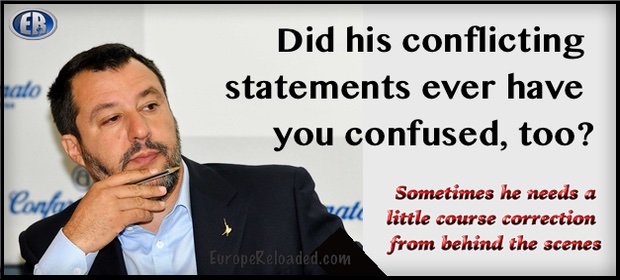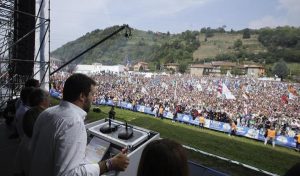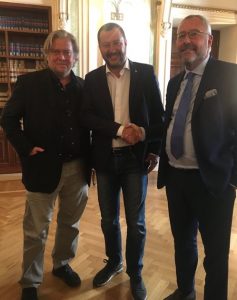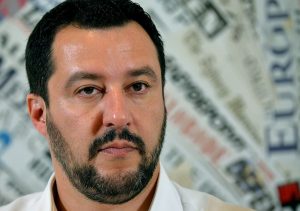
Pam Barker | Director of TLB Europe Reloaded Project
Well, we have long been waiting for an article such as this, on the controlled opposition of Matteo Salvini. In addition to being piqued by his conflicting statements showing on-off support for the neocon/Zionist agenda of Empire (‘let’s have another US base on our doorstep and Soleimani was just a terrorist, but Russia’s ok’), we were mightily curious after his jumping aboard neocon Steve Bannon‘s formerly new, supposedly nationalist party, The Movement, with the Jewish Belgian lawyer and Bannon associate,  Mickael Modrikamen (pictured). Nothing seemed to really take off regarding The Movement; then other nationalist leaders like Marine Le Pen started to distance themselves from Bannon’s movement with not much more of an explanation than ‘Europeans should do their own thing’. Wisely. (Although we wouldn’t be at all surprised to learn that her party constitutes some sort of controlled opposition in France, too.) It’s pretty clear that The Movement is Washington’s attempt to round up and steer Europe’s pro-sovereignty, anti-globalist parties in the direction of its choosing.
Mickael Modrikamen (pictured). Nothing seemed to really take off regarding The Movement; then other nationalist leaders like Marine Le Pen started to distance themselves from Bannon’s movement with not much more of an explanation than ‘Europeans should do their own thing’. Wisely. (Although we wouldn’t be at all surprised to learn that her party constitutes some sort of controlled opposition in France, too.) It’s pretty clear that The Movement is Washington’s attempt to round up and steer Europe’s pro-sovereignty, anti-globalist parties in the direction of its choosing.
Verdi’s (a pen name, obviously) citing a visit by Lilliana Segre to Salvini’s own apartment, conducted in secrecy, isn’t direct proof of anything, but taken in the overall context, it would seem plausible that Segre was quietly telling Salvini to get back in line. Future policies would obviously be a key indicator, none more so than to demonize the BDS movement through legislation, which Salvini has mentioned publicly that he may do.
Do we continue to need more proof of how the entire political game, the theatre of opposition, is artfully crafted to have us fooled?
********
Co-opting Nationalism: The Case of Italy
GIUSEPPE VERDI
For The Saker Blog
Nationalism is dead.
Its stinking corpse is laying in front of Palazzo Montecitorio, home to the Italian Parliament (its increasingly peripheral power centre). People are starting to notice it, people are starting to smell its awful stench. What is left of the brief Italian nationalist experience has finally shown its true, cowardly face, bowing to the international globalist elite and rejecting its truly revolutionary potential.
This is the story of how Italian nationalism has been co-opted by the establishment to serve its wicked agenda.

In November 2019, the news that an 89-year old Italian Holocaust survivor was being put under police protection after she had received multiple death threats made international headlines.  Liliana Segre (pictured with her security detail) an Italian-Jewish activist who was nominated senator-for-life early last year for “social merits” (but really, as a political move from the President to appease a certain part of the intelligentsia) was allegedly receiving two hundred hate messages per day (sic!). As a precaution, she was even assigned a security details consisting of two police officers. Predictably, indignation came loud and clear from mainstream media outlets and every major political figure, in a race to show empathy and support after such inexplicable attacks. Then, some days later the story was quietly retracted. Not only was the number of threats grossly exaggerated, there was also no reliable evidence that those (few) violent messages could be followed up by actual violence. So why would the media and the elites concoct such a masterful display of fake outrage and condemnation? Why would national news stations and talk shows spend hours (!) each day debating something which clearly had no solid foundations to begin with? More crucially, what is the relationship between this now apparently irrelevant news and our initial diagnosis about the state of Italian nationalism?
Liliana Segre (pictured with her security detail) an Italian-Jewish activist who was nominated senator-for-life early last year for “social merits” (but really, as a political move from the President to appease a certain part of the intelligentsia) was allegedly receiving two hundred hate messages per day (sic!). As a precaution, she was even assigned a security details consisting of two police officers. Predictably, indignation came loud and clear from mainstream media outlets and every major political figure, in a race to show empathy and support after such inexplicable attacks. Then, some days later the story was quietly retracted. Not only was the number of threats grossly exaggerated, there was also no reliable evidence that those (few) violent messages could be followed up by actual violence. So why would the media and the elites concoct such a masterful display of fake outrage and condemnation? Why would national news stations and talk shows spend hours (!) each day debating something which clearly had no solid foundations to begin with? More crucially, what is the relationship between this now apparently irrelevant news and our initial diagnosis about the state of Italian nationalism?
In this brief essay, I will develop a nexus between the two, starting with a summary of Italian nationalist politics of the past two years. I will analyse the role Matteo Salvini’s (pictured) League played in devising a nationalist discourse tailored on immigration and Italian identity, what has been said about it and what has been misunderstood. I will also take a look at the supposed “opposition” parties, comparing their ideological background and their social bases. I will argue that the rise of the League and its potential for the international anti-globalist movement has been just a façade, an elaborate project of controlled opposition put in place to mop up votes on the centre-right-to-far-right spectrum, thus crippling truer and more dangerous political movements. The aftermath of the Segre affair and Salvini’s flirting with the Zionist elites will be shown to be a clear testament to this.
Much has been written about the “rise of the far right” and anti-establishment politics in Italy throughout 2018 and 2019. For some time, we enjoyed major coverage on famous neoliberal newspapers such as The Economist and Time Magazine and even a few concerned articles on The Guardian. This will therefore be nothing new. Unfortunately, however, the work of foreign correspondents often tends to be grossly biased, mainly due to linguistic/cultural barriers and political prejudice. On the other hand, when Italians write about Italian politics on foreign media, they tend to oversimplify matters. This makes it impossible to draw meaningful comparisons and to identify the common trends we share with the rest of Europe. Therefore, we will try to fix these problems by providing a background to Italy’s three main political parties and their most recent history, together with an analysis of the geopolitical struggles reflected in Italian politics.


(2019) Matteo Salvini addressing his supporters during the yearly Party meeting in Pontida
The League is the leader of the centre-right coalition, despite having a relatively short history. That said, everyone agrees on one point, namely that in speaking about the League, we must speak of two eras, the one before and the one after Matteo Salvini. From 1995 up until 2013 (when Salvini took over as Secretary), the League was an independentist party, which campaigned mainly on the promise to make Northern Italy (Padania) a federalist entity with special regulatory powers (exploiting some ethnic and cultural differences between the highly industrialised, hard-working North and the less developed, mainly agricultural and “lazy” South). After several experiences as a supporting party in coalition governments led by Silvio Berlusconi, the League could rightly be described as an “establishment conservative” party. From conservative tax reforms to support for Atlanticist interventions in Libya and Syria (the former going quite explicitly against national interest by unleashing a never-ending stream of illegal immigration across the Mediterranean), the League constructed an image of herself as a fully domesticated and complying conservative party. There were (and still are) a few outrageous voices within the party. These are the ones gathering a disproportionate amount of hostile coverage from the MSM, the ones being smeared as “racists”, “xenophobes” and the like. However, these are fringe voices, perhaps used by the very elites to keep the party’s leadership in check. As we already mentioned, after the 2013 Party Congress, Salvini took over and decided to shift the narrative. First, he dropped any reference to Northern independence and federalism (which made the League understandably unpopular in the South), switching to a more internationally codified opposition to the European Union and its bureaucracy. Moreover, he also decided to adopt the “clash of civilizations” trope, becoming the champion of anti-immigration politics, the one issue which still brings him the most consensus among voters. On the other hand, he made sure to maintain two aspects of the previous leadership, namely the appeal to cultural/ethnic Italian values and the unchallenged support for the NATO alliance and the US imperialist project. Salvini is the embodiment (although he does not like to be portrayed as such) of the politician-by-profession. An activist since he was 17, then a degree in History and Politics, interrupted one semester before graduation due to party commitments, he has devoted his life to the party, being able to turn the League from a catalyst of Northern dissatisfaction into a magnet for unfulfilled nationalist sentiments. The key to his success was foreseeing the nationalist wave of 2015-2016 and skilfully riding it, thus bringing the League from lurking in the fringes (8% in its first general elections) to being the first Italian party (with a consensus estimated at 35% according to the most recent polls [January 2020]).


Beppe Grillo (left), the founder of M5S with Luigi Di Maio (right), the current leader
The Democratic Party (PD), on the other hand, is your typical neoliberal party. Over the years, the PD has become deeply entangled in the shady workings of regional and local politics, effectively being identified (and quite rightly) with “the establishment”. PD is usually described as “centre-left” even though the party has followed a trajectory which will be very familiar to the politics reader, and kind of embodies the general decay of the modern left. From full-fledged Communist Party (founded by Antonio Gramsci in 1921), its leadership decided to undergo a complex plastic surgery procedure, renaming it Democratic Party of the Left in 1991, then Democrats of the Left in 1998 (with the party logo finally (?) getting rid of the hammer and sickle symbol), and eventually just Democratic Party in 2007. Together with the aesthetics, they made sure to also gradually adjust the party ideology. From militant communist to socialist, then to moderately reformist and finally to overtly neoliberal after Renzi (an outspoken admirer of Tony Blair) took over the role of Secretary from 2013 to 2017. Now even its staunch supporters are having trouble finding a trace of progressive economic policy, and when party members claim to be “on the side of the workers,” it is always in passing, merely paying lip service to their onerous legacy. Indeed, they surely have had access to state-of-the-art data analysis tools, discovering that Italian workers are not their key demographic reference anymore. Now, as


Matteo Renzi (right), the mastermind of PD’s globalist transformation and Nicola Zingaretti (left), the current Party Secretary
with most of the Western Left, their ideology has been poisoned by neoliberal globalism, focusing on race and gender issues rather than class conflict or vulture capitalism, championing the business of mass immigration and “human rights” in the hope that this new cheap labour force will constitute a rich source of “progressive” voters.
The Five Star Movement (M5S) has been one of the biggest revelations in recent Italian politics. The youngest among the major parties (founded in 2009), it is also the most mysterious in terms of its ideological basis. Born out of the visionary minds of comedian Beppe Grillo and entrepreneur Davide Casaleggio, the movement (which strongly refuses the denomination party) is (or should we say was) centred around its five stars, namely Water, Transport, Development, Connectivity, Environment, the pillars of its early-day activism. It does, at first glance, look like some sort of techno-libertarian conglomerate of activists, like other anti-establishment movements in Europe (one may mention Podemos in Spain or Piratenpartei in Germany). However, the crucial difference is that M5S activists came from the most diverse political experiences (from Communists and Greens, to Fascists and Christian Democrats), thus creating a highly unpredictable mix of ideas and voices. What united them was the resentment towards a political system perceived as corrupt, slow and infiltrated by organised crime. To the old system they were opposing a new, clean alternative, far from the nepotistic workings of Italian politics and against the neoliberal logic to which other parties had been enslaved since the late 1990s. Currently headed by Luigi Di Maio, a young Law School dropout with no prior experience in politics, the party has missed a huge chance of becoming the nationalist/identitarian vanguard, mainly because of a substantial lack of a shared political philosophy. What made the movement exciting and uncontrollable also turned out to be its major weakness. M5S leadership was not able to exploit the ideology vacuum and fill it with a coherent political strategy. Eurasianism (or even a milder form of geopolitical consciousness) could have very well constituted the perfect foundation for this new populist force, thus bringing together voices from very different backgrounds and uniting them in one clear goal, the rejection of the neoliberal globalist dogmas and the advancement of the multipolar world order. However, this did not (and at this point will not) happen. The Five Star Movement remains a blank canvas of MPs and Senators, so far cleverly exploited by both the League and the Democratic Party to advance their agendas.
Now this last statement requires some further explanation, which will come in the form of a brief political chronology of the past two years. After the March 2018 elections, Italian politics reached an impasse. Luigi Di Maio’s M5S (running alone) obtained an impressive 35.9% share of the votes. The centre-right coalition managed to gather a 41.5%, with the League leading at 19.6%. The Democratic Party and its centre-left coalition reached about 20%, although this marked its worst performance since the birth of the party. Since the Five Star Movement obtained the highest number of votes but not enough to govern alone, the President of the Republic tasked Di Maio with finding a suitable partner. After three months of intense debates and negotiations, the M5S formed a controversial coalition government with the League, based on a shared “government contract”, a list of programmatic points and legislative proposals agreed upon in advance by both parties. Ministries and appointments were therefore divided between the two, with Salvini becoming Minister of the Interior and Di Maio heading the Ministry of Economic Development. Giuseppe Conte, a lawyer and academic from the University of Rome, was appointed Prime Minister jointly by the two forces, while Salvini and Di Maio assigned themselves the purely nominal role of Deputy Prime Ministers. In the following year, Salvini skilfully managed to suck up an enormous amount of consensus from the M5S by leading a personal crusade against illegal immigration. Going routinely on Facebook rants against the degradation of Italian peripheries and being hosted every other day on talk shows to debate braindead leftists, he made sure to gain a lot of popularity. Popularity which was not even remotely matched by the M5S, entangled since the very start in a severely flawed and controversial proposal to institute a lighter version of universal basic income, clearly unpopular among all working Italians. Then, after a mere thirteen months, Salvini put through a motion of no confidence to his own PM, citing a hostile climate between the League and M5S as a reason. Analysts believe this was his plan all along. After having drained the Five Star Movement of all its consensus by attributing all the delays and shortcomings to its coalition partners, the League would come out of new elections as the leading party. It appears, however, that while in university, Salvini did not take enough Constitutional Law classes. Indeed, after the motion was passed, the President gave PM Conte a mandate to form a new government, completely sidestepping the League. Predictably, the M5S quickly ran to the Democratic Party, its sworn enemy, to build a new majority. Both of them (fearing new elections and a likely League victory) quickly agreed to form a government. As of now (January 2020), the two forces are currently in power, while the centre-right coalition is confined to the opposition and is raking up an even bigger consensus (not just in the polls but also in local elections, the most recent of which saw the League candidate win with an unprecedented 57% of the preferences). Only time will tell whether the current majority will hold until the end of the legislature (2023) or if the Italian people will be asked to vote again before this time. What is clear is that both M5S and the Democratic Party fear Salvini’s consensus (the only reason why they agreed to form a government). Hence, unless a very serious crisis erupts or the two leaderships feel confident enough to challenge Salvini at the polls, we should expect this project to continue.
Now let us get back to the beginning. It appears now at first glance that nationalism (embodied by the first coalition government) is finally dead, killed by cunning politicians with the help of legal subterfuges. Once we give a closer look, however, we come to the conclusion that nationalism was never alive in the first place. That the League was not going to be the true catalyst of European nationalist forces (as pundits in The Guardian feared) was already quite clear. The first doubts surfaced when the League was one of the very first (and few) to join The Movement, the (neoconservative) nationalist international led by Steve Bannon. Right after the European elections of 2018, Bannon toured Europe to export the American (and Zionist) character of Trumpian nationalism to emerging European nationalist parties. Needless to say, the League was the most prominent members of this new group, with Bannon endorsing the Italian nationalist project and declaring Salvini a “world-class leader”. Other notable yet less known red flags include Salvini’s unwarranted remarks about Hezbollah during a visit to Jerusalem in late 2018, and his ground-breaking discovery of Israel being “a bastion of democracy in the Middle East” (source). Moreover, during a hostile televised debate with one of Italy’s most renowned globalist media outlets, while smearing Iran as a “global danger”, he made it perfectly clear that “neither I nor my government will engage with those who want to erase a state and a people with violence” (source). A few well-informed commentators have highlighted these contradictions, also drawing interesting parallels with the well-known brand of Trumpian nationalism and, crucially, Israeli nationalism [see an example here (Italian)].


Matteo Salvini (centre) meeting Steve Bannon (left) in Rome
[Addendum: In light of recent developments in the Near East, we shall point out one positive outcome of this government transition. Despite Italy’s diplomatic weight being irrelevant on the world stage at this time, it comes as positive news that the government has decided to keep extremely quiet in this first stage of US-Iran clashes, joining other EU countries in the call for a peaceful solution. On the other hand, Salvini was quick to side with President Trump and to label Commander Soleimani a “terrorist”. One may only wonder what would have happened if the League and its Zionist leadership were still in power and what effects it could have had on other European countries].
That said, it should now be clear that the international globalist elite cannot be afraid of Salvini trying to destabilise the Leviathan’s stronghold in the Near East. What about his open and vocal support of Russia and President Putin (for which he has received much condemnation from the MSM)? Once again, we need to look at this issue from the broader perspective of the Anglo-European nationalist project (or souverainisme as the media likes to label it with veiled irony). As a very informative article has already pointed out, Salvini and the new nationalists view Russia not as an instrumental ally in bringing about the multipolar world order, but rather as a means to weaken the opposition to the Empire in the East. By drawing Russia closer, they seek to hinder her alliances with strategic partners in the Near and Middle East, with the ultimate goal of pushing China away. As one Eurasian analyst put it, the Western nationalists’ real aim behind their love story with Russia is “breaking the Moscow-Teheran-Damascus axis” (Perra, 2019, see the above article) and therefore strengthening the unipolar balance of power described by Charles Krauthammer. Since the elections of 2018, it has become painfully clear that the League is nothing more than an elaborate project of controlled opposition. A party removed from its original federalist context and projected into the international arena. A party which has been used by the elites to promote a vanilla version of right-wing 21st Century politics, drawing consensus away from more unpredictable fringe political forces such as the M5S, Casa Pound Italia (CPI) or the Italian Communist Party, so far the only ones daring to speak critically of the American military occupation of Italy and to question the neoliberal project and its globalist elites. Indeed, the overwhelming support the League enjoys is mainly rooted in its attitude towards immigration (which has been greatly exaggerated by an insanely biased media coverage) and stems from the hope that, with someone like him in power, Italy will not go down the same road as France or England. Moreover, Salvini’s consensus also crucially hinges on the deep-seated Italian Catholic identity, which makes nearly everyone instinctively resonate with Salvini’s anti-degeneracy rants (such as his vocal opposition to adoption for homosexual couples) and his (at least for now) opposition to the homosexual agenda. Apart from these crucial features, there is very little difference between say, the League’s economic policies and those of some LSE-educated (ER: think Rockefeller, Soros) technocrats from the Democratic Party. As always under the globalist world order, questioning neoliberal dogmas has become the new original sin, and none of the Italian mainstream political parties is willing to commit it.
With all of this said, however, we can still hold a reasonable doubt about the League’s true intentions. After all, one might think Salvini would be wise enough to fake his support for the Zionist elite in order to get ahead in the polls, while at the same time being secretly against the Atlanticist project. Indeed, this is exactly what the elites fear. This is why the MSM has been engaged in a ferocious campaign to smear Salvini and the League’s leadership, in an effort to find out his truest intentions. This is also why Salvini is currently being subjected to several (political) prosecutions by distinguished members of the judiciary, with the spectre of prison constantly haunting him. And this is where the Segre affaire comes into play.
The supposed “incident” happened in the aftermath of a vote instituting a “hate speech” Commission inside the Senate. The bill, which ultimately passed without the votes of the League’s senators, was spearheaded by Segre herself. Indeed, in an interview from 2018, she went as far as suggesting that her appointment as senator made her think that she could use it to push for this legislation to go through (the interview can be found here). The “Segre Commission” (as the media labelled it) is going to be a special Senate Commission tasked with identifying instances of
“intolerance, racism, antisemitism, incitement to hate and violence towards individuals or social groups on the basis of certain characteristics such as ethnicity, religion, origin, sexual orientation, gender, or other physical and psychological conditions” [full text in Italian here]
Moreover, it will be able to produce papers and suggestions to Parliament, including those concerning legislation intended to curb such phenomena. Those who have followed any political debate in the past three years will surely be familiar with this kind of jargon and its origin. Lawfare has become more and more prominent in contemporary politics, being used by the ruling class not only to silence opposition (without losing the very much inflated democratic label) but also to socially engineer our societies, implicitly teaching what is and what is not appropriate. Now, it is obviously difficult to predict to what extent, if any, this Commission will be weaponised against political leaders or controversial intellectuals. Indeed, in an era where the media is at the same time judge, jury and executioner when it comes to political and social matters, perhaps such a Commission would appear redundant. What is likely to happen, however, is that the Commission (the more we write it, the more it begins to sound Orwellian) will use its powers to single out controversial figures (and we do not mean fringe, internet-based controlled opposition, but rather sound, educated voices with dissenting opinions on globalist dogmas) and force them into silence (with the full weight of the law).


Matteo Salvini


Liliana Segre
At this time, however, we are not particularly interested in the Commission per se, but rather in the media coverage that followed the Senate vote. Tellingly enough, the media narrative focused on centre-right senators not casting their vote. The spotlight has been on the League, whose members were apparently “told” to abstain, citing the quite evident risk of an infringement on free speech. Naturally, most of the blame was cast on Salvini, who was “forced” by the media to endure days of public shaming on virtually every news network, until he finally agreed to entertain a meeting with Liliana Segre in her private apartment in Rome. Salvini later declined to disclose the subject of the meeting. Nonetheless, the fact that Segre had received a letter from none other than  Israeli President Rivlin (pictured), expressing “horror and disgust” for what had happened is enough to interpret this as a symbolic investiture of the Senator by the Zionist elite. It is now clear that the meeting was some sort of official warning to Salvini, a way of telling him (using the most harmless of messengers) that the Zionist elite is watching his every step. A clear reminder that those who put him where he is now will not tolerate any delay to their plans. It is also not unreasonable to predict new pro-Zionist legislation proposals coming from League members in an effort to signal increased support. Salvini himself has recently suggested (in a brief interlude during a talk show) that the League will be devising legislation akin to the anti-BDS laws of North America, perhaps going as far as labelling criticism of Israel and Zionism as “anti-Semitic”. If you want to remain relevant and out of trouble, you must kowtow to the right people.
Israeli President Rivlin (pictured), expressing “horror and disgust” for what had happened is enough to interpret this as a symbolic investiture of the Senator by the Zionist elite. It is now clear that the meeting was some sort of official warning to Salvini, a way of telling him (using the most harmless of messengers) that the Zionist elite is watching his every step. A clear reminder that those who put him where he is now will not tolerate any delay to their plans. It is also not unreasonable to predict new pro-Zionist legislation proposals coming from League members in an effort to signal increased support. Salvini himself has recently suggested (in a brief interlude during a talk show) that the League will be devising legislation akin to the anti-BDS laws of North America, perhaps going as far as labelling criticism of Israel and Zionism as “anti-Semitic”. If you want to remain relevant and out of trouble, you must kowtow to the right people.
To sum up this brief overview of Italian nationalist politics, we have tried to make sense of a rather complex environment and visualise the international equilibria reflecting into the three main Italian parties. The League is gaining consensus at an unprecedented rate, being now the leading party according to the polls. What drives this consensus is mainly Salvini’s anti-immigration rhetoric (which has so far been only partially followed up by actual policy). Aside from immigration and a mild social conservatism, the League is no more a nationalist movement than your average European establishment conservative party. From neoliberal economic policies to the loud and clear support for Israel and US occupation in the Near East, Salvini skilfully managed to construct and maintain the image of a Zionist-friendly party. Although the Democratic Party (with its utter detachment from the working class, the shameless support for mass immigration and the global homosexual cabal) is still the elites’ favourite, the two (ER: and the League) have been (secretly) working together with the same goal, namely eliminating any potential threat to the system. The Five Star Movement, with its lack of a coherent ideological basis, has been the most distinguished casualty in this campaign. Therefore, the League, once heralded by European nationalists as the one true hope for the radical identitarian right (or at least as an alley in which to channel those sentiments) is now fully part of the neoliberal establishment. As the elites wait for its leadership to abandon even the last tokens of real Conservatism and Tradition, the League’s fate seems to be already written. It is no longer a matter of if, but of when.
GV
************
Original article

••••
The Liberty Beacon Project is now expanding at a near exponential rate, and for this we are grateful and excited! But we must also be practical. For 7 years we have not asked for any donations, and have built this project with our own funds as we grew. We are now experiencing ever increasing growing pains due to the large number of websites and projects we represent. So we have just installed donation buttons on our websites and ask that you consider this when you visit them. Nothing is too small. We thank you for all your support and your considerations … (TLB)
••••
Comment Policy: As a privately owned web site, we reserve the right to remove comments that contain spam, advertising, vulgarity, threats of violence, racism, or personal/abusive attacks on other users. This also applies to trolling, the use of more than one alias, or just intentional mischief. Enforcement of this policy is at the discretion of this websites administrators. Repeat offenders may be blocked or permanently banned without prior warning.
••••
Disclaimer: TLB websites contain copyrighted material the use of which has not always been specifically authorized by the copyright owner. We are making such material available to our readers under the provisions of “fair use” in an effort to advance a better understanding of political, health, economic and social issues. The material on this site is distributed without profit to those who have expressed a prior interest in receiving it for research and educational purposes. If you wish to use copyrighted material for purposes other than “fair use” you must request permission from the copyright owner.
••••
Disclaimer: The information and opinions shared are for informational purposes only including, but not limited to, text, graphics, images and other material are not intended as medical advice or instruction. Nothing mentioned is intended to be a substitute for professional medical advice, diagnosis or treatment.




